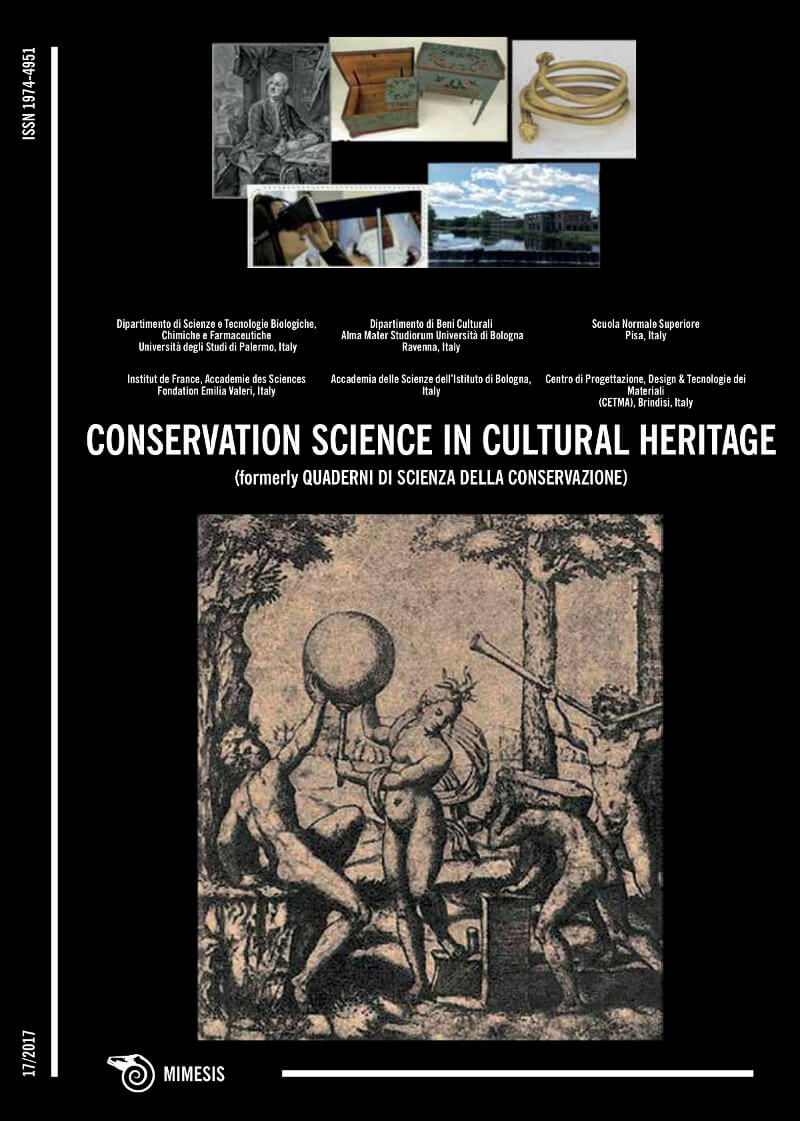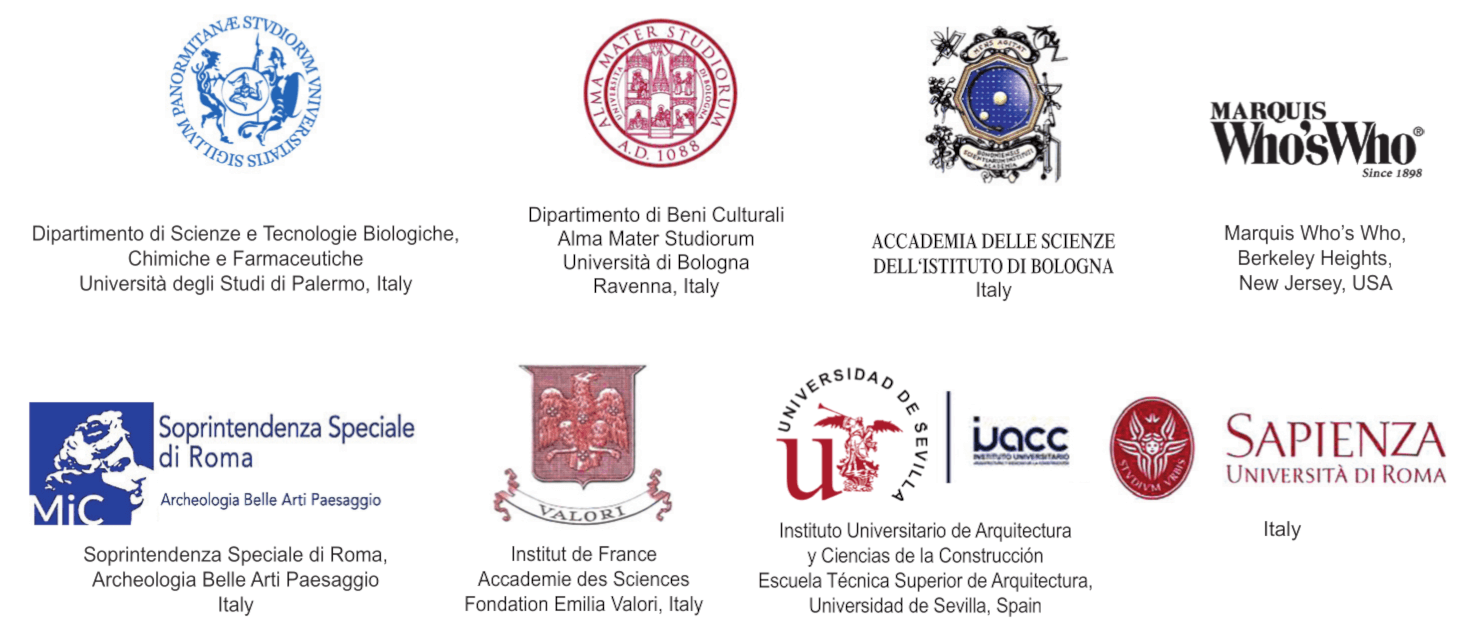Raman Identification of Pigments in Wall Paintings of the Colonial Period from Bolivian Churches in the Ruta De La Plata
DOI:
https://doi.org/10.6092/issn.1973-9494/7945Keywords:
Andean colonial churches, wall paintings, pigments, Raman spectroscopyAbstract
Micro-Raman spectroscopy was used to analyze and identify pigments and determine the palette of color in wall paintings from four churches of the Colonial Period, in the Bolivian highlands. The ancient churches Santiago de Callapa, Curahuara de Carangas, NuestraSeñora de Copacabana de Andamarca and San José de Soracachi were constructed during the 17th and 18th centuries, around the important colonial Ruta de la Plata, between Potosí city and Arica harbor on the Pacific coast of South America. Most pigments used in the wall paintings correspond to inorganic minerals as well as to organic colorants. Fully chlorinated copper phthalocyanine (green), copper phthalocyanine (blue), β-naphthol (yellow) and benzoimidazolone (red), were identified in the corresponding colored areas suggesting subsequent recent interventions or restorations. Ground layer materials were also characterized. The present results allow for discussion of the pictorial techniques used in the Andean highland during the colonial period and allow conservators and restorers to make important decisions regarding the type of intervention to perform in the case of these important historical and patrimonial monuments.References
Guzmán, F., Corti, P., Pereira, M. (2014). Imagen y palabra en la evangelización y catequesis de la Ruta de La Plata. Potosi–Arica. Hispania Sacra, 66, pp. 119-168.
Rivera, M.A. (1995). Arica en las rutas de tráfico de Potosí: Algunas consideraciones sobre la sociedad andina del siglo XVIII. Revista Chilena de Antropología, 13, pp. 99-136.
Bernabeu A. S. (2010). Poblar la inmensidad: sociedades, conflictividad y representación en los márgenes del Imperio Hispánico (siglos XV-XIX). Barcelona, Ediciones Rubeo-CSIC, pp 401.
Salazar, P.M.d.A.P.y. (1854).Constituciones sinodales del Arzobispado de la Plata, Cochabamba, P.M. de Argandoña Pastén y Salazar ED.
Vargas, I. (2008). La Iglesia de Curahuara de Carangas: La Capilla Sixtina Del Altiplano, La Paz, Universidad Católica Boliviana San Pablo.
Gisbert, T. (1992). La pintura mural andina. Colonial Latin American Review, 1(1), pp. 109-145.
Guzmán, F.,Maier, M.,Pereira, M., Sepúlveda, M., Siracusano, G., Cárcamo, J., Castellanos, D., Gutiérrez, S.,Tomasini, E., Corti, P., Rúa, C. (2016). Programa iconográfico y material en las pinturas murales de la iglesia de San Andrés de Pachama, Chile. Colonial Latin American Review, 25(2) pp. 245-264.
Baraldi, P., Tinti, A. (2008). Raman spectroscopy in art and archaeology. Journal of Raman spectroscopy, 39(8), pp. 963-965.
Vandenabeele, P., Edwards, H.G., Moens, L. (2007). A decade of Raman spectroscopy in art and archaeology. Chemical Reviews, 107(3), pp. 675-686.
Burgio,L., Clark, R.J.H., Stratoudaki, T., Doulgeridis, M., Anglos, D. (2000). Pigment identification in painted artworks: A dual analytical approach employing laser-induced breakdown spectroscopy and Raman microscopy. Appl. Spectrosc., 54(4), pp. 463-469.
Colomban, P. Treppoz, F. (2001). Identification and differentiation of ancient and modern European porcelains by Raman macro‐and micro‐spectroscopy. Journal of Raman spectroscopy, 32(2), pp. 93-102.
Liem, N.Q.,Sagon, G.,Quang, V.X., Tan, H.V., Colomban, P. (2000). Raman study of the microstructure, composition and processing of ancient Vietnamese (proto) porcelains and celadons (13-16th centuries). Journal of Raman spectroscopy, 31(10), pp. 933-942.
Bellot-Gurlet, L., Pagès-Camagna, S., Coupry, C. (2006). Raman spectroscopy in art and archaeology. Journal of Raman Spectroscopy, 37(10), pp. 962-965.
Bersani, D., Lottici, P. (2016). Raman spectroscopy of minerals and mineral pigments in archaeometry. Journal of Raman Spectroscopy, 47(5), pp. 499-530.
Casadio, F., Daher, C., Bellot-Gurlet, L. (2016). Raman Spectroscopy of cultural heritage Materials: Overview of applications and new frontiers in instrumentation, sampling modalities, and data processing. Topics in Current Chemistry, 374(5), 62, pp. 1-55.
Anglos, D., Couris, S., Fotakis, C. (1997). Laser diagnostics of painted artworks: laser-induced breakdown spectroscopy in pigment identification. Appl. Spectrosc., 51(7), pp. 1025-1030.
Boucherit, N., Hugot-Le Goff, A., Joiret, S. (1991). Raman studies of corrosion films grown on Fe and Fe-6Mo in pitting conditions. Corrosion Science, 32(5), pp. 497-507.
Thibeau, R.J., Brown, C.W., Heidersbach, R.H. (1978). Raman spectra of possible corrosion products of iron. Appl. Spectrosc., 32(6), pp. 532-535.
De Faria, D., Venâncio Silva, S., De Oliveira, M. (1997). Raman microspectroscopy of some iron oxides and oxyhydroxides. Journal of Raman spectroscopy, 28(11), pp. 873-878.
Adar, F., Lee, E., Whitley, A., Witkowski, M. (2007). Single-point analysis and Raman mapping of tablet dosage formulation as a means for detecting and sourcing counterfeit pharmaceuticals. Raman Technology for Today’s Spectroscopists, 8–20.
Smith, G.D. Clark, R.J. (2004). Raman microscopy in archaeological science. Journal of Archaeological Science, 31(8), pp. 1137-1160.
Sepúlveda, M., E. Laval, L. Cornejo Y J. Acarapi. (2012). Elemental characterization of pre-hispanic rock art and arsenic in northern Chile. Rock Art Research 29(1), 93-107.
Gómez González, M.L. (1998). La restauración: examen científico aplicado a la conservación de obras de arte, Madrid, Instituto del Patrimonio Histórico Español.
Lin-Vien, D.,Colthup, N.B., Fateley, W.G., Grasselli, J.G. (1991). The handbook of infrared and Raman characteristic frequencies of organic molecules. California, Academic Press.
Scherrer, N.C., Stefan, Z., Francoise, D., Annette, F., Renate, K. (2009). Synthetic organic pigments of the 20th and 21st century relevant to artist's paints: Raman spectra reference collection. Spectrochimica Acta Part A: Molecular and Biomolecular Spectroscopy, 73(3), pp. 505-524.
Olave, C., Carrasco, E., Campos-Vallette, M., Saavedra, M., Diaz, G., Clavijo, R., Figueroa, W., Garcı́a-Ramos, J., Sanchez-Cortes, S., Domingo, C. (2002).Vibrational study of the interaction of dinaphthalenic Ni (II) and Cu (II) azamacrocycle complexes methyl and phenyl substituted with different metal surfaces. Vibrational spectroscopy, 28(2), pp. 287-297.
Burgio, L., Clark, R.J.H (2001). Library of FT-Raman spectra of pigments, minerals, pigment media and varnishes, and supplement to existing library of Raman spectra of pigments with visible excitation. Spectrochimica Acta Part A: Molecular and Biomolecular Spectroscopy, 57(7), pp. 1491-1521.
Vandenabeele, P., Moens, L.,Edwards, H.G., Dams, R. (2000). Raman spectroscopic database of azo pigments and application to modern art studies. Journal of Raman spectroscopy, 31(6), pp. 509-517.
Pozzi, F., Lombardi, J.R., Leona, M. (2013).Winsor & Newton original handbooks: a surface-enhanced Raman scattering (SERS) and Raman spectral database of dyes from modern watercolor pigments. Heritage Science, 1(1), pp. 23.
Basova, T.V., Kiselev, V.G., Schuster, B.E., Peisert, H., Chassé, T. (2009).Experimental and theoretical investigation of vibrational spectra of copper phthalocyanine: polarized single-crystal Raman spectra, isotope effect and DFT calculations. Journal of Raman spectroscopy, 40(12), pp. 2080-2087.
Colombini, A., Kaifas, D. (2010).Characterization of some orange and yellow organic and fluorescent pigments by Raman spectroscopy. Preservation Science, 7, pp. 14-21.
Downs, R. (2006). The RRUFF Project: an integrated study of the chemistry, crystallography, Raman and infrared spectroscopy of minerals, in: Program and abstracts of the 19th general meeting of the international mineralogical association in Kobe, Japan. 03-13.
Estaugh, N., WalshV., Chaplin, T., Siddall, R. (2004).The Pigment Compendium: Optical Microscopy of Historical Pigments, Butterworth-Heinemann, Elsevier.
Chaplin, T.D., Clark, R.J.H, Martinón-Torres, M. (2010). A combined Raman microscopy, XRF and SEM–EDX study of three valuable objects–A large painted leather screen and two illuminated title pages in 17th century books of ordinances of the Worshipful Company of Barbers, London. Journal of Molecular Structure, 976(1),pp. 350-359.
Chaplin, T.D., Clark, R.J.H., McKay, A., Pugh, S. (2006). Raman spectroscopic analysis of selected astronomical and cartographic folios from the early 13th century, ‘Book of Curiosities of the Sciences and Marvels for the Eyes’. Journal of Raman spectroscopy, 37(8), pp. 865-877.
Lutzenberger, K. and Stege, H. (2009). From Beckmann to Baselitz-towards an improved micro-identification of organic pigments in paintings of 20th century art. Preservation Science, 6, pp. 89-100.
Baran, A., Fiedler, A., Schulz, H., Baranska, M. (2010). In situ Raman and IR spectroscopic analysis of indigo dye. Analytical Methods, 2(9), pp. 1372-1376.
Leona, M., Casadio, F., Bacci, M., Picollo, M. (2004). Identification of the Pre-Columbian Pigment Mayablue on Works of Art by Noninvasive UV-Vis and Raman Spectroscopic Techniques. Journal of the American Institute for Conservation, 43(1), pp. 39-54.
Martens, W., Frost, R.L., Kloprogge, J.T., Williams, P.A. (2003). Raman spectroscopic study of the basic copper sulphates—implications for copper corrosion and ’bronze disease. Journal of Raman spectroscopy, 34(2), pp. 145-151.
Lane, M.D. (2007). Mid-infrared emission spectroscopy of sulfate and sulfate-bearing minerals. American Mineralogist, 92(1), pp. 1-18.
Liu, Y., Wang, A., Freemen, J. (2009). Raman, MIR, and NIR spectroscopic study of calcium sulfates: gypsum, bassanite, and anhydrite, in: Lunar and Planetary Science Conference, pp. 2128.
Frost, R.L., López, A., Scholz, R., Xi, Y., da Silveira, A.J., Lima, R.M.F. (2013). Characterization of the sulphate mineral amarantite–using infrared, Raman spectroscopy and thermogravimetry. Spectrochimica Acta Part A: Molecular and Biomolecular Spectroscopy, 114, pp. 85-91.
Contakes, S.M., Beatty, S.T., Dailey, K.K., Rauchfuss, T.B., Fenske, D. (2000). π-Complexes of Phthalocyanines and Metallophthalocyanines. Organometallics, 19(23), pp. 4767-4774.
Legodi, M., De Waal, D. (2007).The preparation of magnetite, goethite, hematite and maghemite of pigment quality from mill scale iron waste. Dyes and Pigments, 74(1),pp. 161-168.
Periasamy, A., Muruganand, S., Palaniswamy, M. (2009).Vibrational studies of Na2SO4, K2SO4, NaHSO4 and KHSO4 crystals. Rasayan J. Chem, 2(4), pp. 981-989.
Schulte, F., Brzezinka, K.-W., Lutzenberger, K., Stege, H., Panne, U. (2008).Raman spectroscopy of synthetic organic pigments used in 20th century works of art. Journal of Raman spectroscopy, 39 (10), pp. 1455-1463.
West Fitzhugh, E. (1997). Artist’s Pigments: a Handbook of their history and characteristics, Washington, DC, Estados Unidos, National Gallery of Art.
White,S.N. (2009). Laser Raman spectroscopy as a technique for identification of seafloor hydrothermal and cold seep minerals. Chemical Geology, 259(3), pp. 240-252.
Siracusano, G. (2005). Colores en los Andes. Hacer, saber y poder, in: Nuevo Mundo Mundos Nuevos. Nouveaux mondes mondes nouveaux-Novo Mundo Mundos Novos-New world New worlds. Expositions virtuelles, INNS: 1626-0252.
Tomasini, E., Rodríguez, D.C., Gómez, B.A., de Faria, D.L., Landa, C.R., Siracusano, G., Maier, M.S. (2016). A multi-analytical investigation of the materials and painting technique of a wall painting from the church of Copacabana de Andamarca (Bolivia). Microchemical Journal, 128, pp. 172-180.
Tomasini, E. P., Halac, E. B., Reinoso, M., Di Liscia, E. J., and Maier, M. S. (2012). Micro‐Raman spectroscopy of carbon‐based black pigments. Journal of Raman Spectroscopy, 43(11), pp. 1671-1675.
Seldes, A., Burucúa, J.E., Siracusano, G., Maier, M. S., Abad, G.E. (2002).Green, yellow, and red pigments in South American painting, 1610–1780. Journal of the American Institute for Conservation, 41(3), pp. 225-242.
Seldes, A.M., Burucúa, J.E., Maier, M.S., Abad, G., Jáuregui, A., Siracusano, G. (2013). Blue pigments in South American painting (1610–1780). Journal of the American Institute for Conservation, 38(2), pp. 100-123.
Eastaugh, N., Walsh, V.,Chaplin, T., Siddall, R. (2007). Pigment compendium: a dictionary of historical pigments. Butterworth- Heinemann, Elsevier.
Sepúlveda, M., Figueroa, V., Cárcamo, J. (2014). Pigmentos y pinturas de mineral de cobre en la región de Tarapacá, norte de Chile: nuevos datos para una tecnología pigmentaria prehispánica. Estudios atacameños, 48, pp. 23-37.
Sepúlveda, M., Rousseliere, H., Van Elslande, E., Arriaza, B., Standen, V., Santoro, C.M., Walter, P. (2014). Study of color pigments associated to archaic chinchorro mummies and grave goods in Northern Chile (7000–3500 BP). Heritage Science, 2(1), pp. 1.
Siracusano, G. (2005). El poder de los colores: De lo material a lo simbólico en las prácticas culturales andinas. Siglos XVI-XVIII. AdVersuS: Revista de Semiótica, 3, pp. 14.
Prieto, G., Wright, V., Burger, R.L., Cooke, C.A., Zeballos-Velasquez, E.L., Watanave, A., Suchomel, M.R., Suescun, L. (2016). The source, processing and use of red pigment based on hematite and cinnabar at Gramalote, an early Initial Period (1500–1200cal. BC) maritime community, north coast of Peru. Journal of Archaeological Science: Reports, 5, pp. 45-60.
Downloads
Published
How to Cite
Issue
Section
License
Copyright (c) 2017 Carlos Rúa, Marcela Sepúlveda, Sebastián Gutiérrez, José J. Cárcamo-Vega, Julio Surco-Luque, Marcelo Campos-Vallette, Fernando Guzmán, Paola Conti, Magdalena Pereira
Copyrights and publishing rights of all the texts on this journal belong to the respective authors without restrictions. Authors grant the journal right of first publication.This journal is licensed under a Creative Commons Attribution 3.0 Unported License. (full legal code)See also our Open Access Policy.






